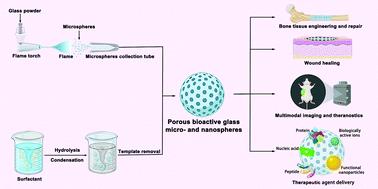当前位置:
X-MOL 学术
›
Mater. Horiz.
›
论文详情
Our official English website, www.x-mol.net, welcomes your feedback! (Note: you will need to create a separate account there.)
Porous bioactive glass micro- and nanospheres with controlled morphology: developments, properties and emerging biomedical applications
Materials Horizons ( IF 13.3 ) Pub Date : 2020-11-04 , DOI: 10.1039/d0mh01498b Kai Zheng 1 , Baiyan Sui , Kanwal Ilyas , Aldo R Boccaccini
Materials Horizons ( IF 13.3 ) Pub Date : 2020-11-04 , DOI: 10.1039/d0mh01498b Kai Zheng 1 , Baiyan Sui , Kanwal Ilyas , Aldo R Boccaccini
Affiliation

|
In recent years, porous bioactive glass micro/nanospheres (PBGSs) have emerged as attractive biomaterials in various biomedical applications where such engineered particles provide suitable functions, from tissue engineering to drug delivery. The design and synthesis of PBGSs with controllable particle size and pore structure are critical for such applications. PBGSs have been successfully synthesized using melt-quenching and sol–gel based methods. The morphology of PBGSs is controllable by tuning the processing parameters and precursor characteristics during the synthesis. In this comprehensive review on PBGSs, we first overview the synthesis approaches for PBGSs, including both melt-quenching and sol–gel based strategies. Sol–gel processing is the primary technology used to produce PBGSs, allowing for control over the chemical compositions and pore structure of particles. Particularly, the influence of pore-forming templates on the morphology of PBGSs is highlighted. Recent progress in the sol–gel synthesis of PBGSs with sophisticated pore structures (e.g., hollow mesoporous, dendritic fibrous mesoporous) is also covered. The challenges regarding the control of particle morphology, including the influence of metal ion precursors and pore expansion, are discussed in detail. We also highlight the recent achievements of PBGSs in a number of biomedical applications, including bone tissue regeneration, wound healing, therapeutic agent delivery, bioimaging, and cancer therapy. Finally, we conclude with our perspectives on the directions of future research based on identified challenges and potential new developments and applications of PBGSs.
中文翻译:

具有可控形态的多孔生物活性玻璃微球和纳米球:发展、特性和新兴的生物医学应用
近年来,多孔生物活性玻璃微/纳米球(PBGS)已成为各种生物医学应用中有吸引力的生物材料,这些工程颗粒提供合适的功能,从组织工程到药物输送。具有可控粒径和孔结构的 PBGS 的设计和合成对于此类应用至关重要。PBGSs 已使用熔融淬火和溶胶-凝胶法成功合成。PBGS 的形态可通过在合成过程中调整工艺参数和前体特性来控制。在这篇关于 PBGS 的综合综述中,我们首先概述了 PBGS 的合成方法,包括基于熔体淬火和溶胶-凝胶的策略。溶胶-凝胶加工是用于生产 PBGS 的主要技术,允许控制颗粒的化学成分和孔结构。特别强调了成孔模板对PBGSs形态的影响。具有复杂孔结构的 PBGS 的溶胶-凝胶合成的最新进展(例如,中空介孔、树枝状纤维介孔)也被覆盖。详细讨论了关于控制颗粒形态的挑战,包括金属离子前体和孔膨胀的影响。我们还强调了 PBGS 在许多生物医学应用中的最新成就,包括骨组织再生、伤口愈合、治疗剂递送、生物成像和癌症治疗。最后,我们根据已确定的挑战以及 PBGS 的潜在新发展和应用,对未来研究方向提出了我们的看法。
更新日期:2020-11-27
中文翻译:

具有可控形态的多孔生物活性玻璃微球和纳米球:发展、特性和新兴的生物医学应用
近年来,多孔生物活性玻璃微/纳米球(PBGS)已成为各种生物医学应用中有吸引力的生物材料,这些工程颗粒提供合适的功能,从组织工程到药物输送。具有可控粒径和孔结构的 PBGS 的设计和合成对于此类应用至关重要。PBGSs 已使用熔融淬火和溶胶-凝胶法成功合成。PBGS 的形态可通过在合成过程中调整工艺参数和前体特性来控制。在这篇关于 PBGS 的综合综述中,我们首先概述了 PBGS 的合成方法,包括基于熔体淬火和溶胶-凝胶的策略。溶胶-凝胶加工是用于生产 PBGS 的主要技术,允许控制颗粒的化学成分和孔结构。特别强调了成孔模板对PBGSs形态的影响。具有复杂孔结构的 PBGS 的溶胶-凝胶合成的最新进展(例如,中空介孔、树枝状纤维介孔)也被覆盖。详细讨论了关于控制颗粒形态的挑战,包括金属离子前体和孔膨胀的影响。我们还强调了 PBGS 在许多生物医学应用中的最新成就,包括骨组织再生、伤口愈合、治疗剂递送、生物成像和癌症治疗。最后,我们根据已确定的挑战以及 PBGS 的潜在新发展和应用,对未来研究方向提出了我们的看法。



























 京公网安备 11010802027423号
京公网安备 11010802027423号